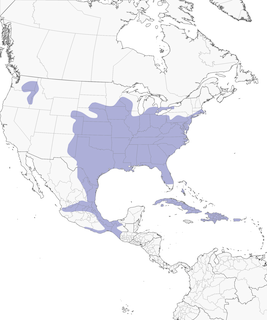Northern BobwhiteColinus virginianusScientific name definitions
- NTNear Threatened
- Names(42)
- Subspecies (21)
Text last updated September 9, 2014
Sign in to see your badges

Sign in to see your badges
| Language | Common name |
|---|---|
| Afrikaans | Noordelike Kwartel |
| Azerbaijani | Vircinya bildirçini |
| Basque | Kolin virginiarra |
| Bulgarian | Вирджински пъдпъдък |
| Catalan | colí de Virgínia |
| Croatian | virdžinijska prepelica |
| Czech | křepel virginský |
| Danish | Bobwhite |
| Dutch | Bobwhite |
| English | Northern Bobwhite |
| English (AVI) | Northern Bobwhite |
| English (United States) | Northern Bobwhite |
| Estonian | nurmvutt |
| Finnish | peltoviiriäinen |
| French | Colin de Virginie |
| German | Virginiawachtel |
| Greek | Δεντροπέρδικα του Βορρά |
| Haitian Creole (Haiti) | Kay |
| Hebrew | שליו אמריקני |
| Hungarian | Bozótfürj |
| Icelandic | Tannhæna |
| Italian | Colino della Virginia |
| Japanese | コリンウズラ |
| Latvian | Virdžīnijas paipala |
| Lithuanian | Virgininė putpelė |
| Norwegian | nordkrattvaktel |
| Polish | przepiór wirginijski |
| Portuguese (Portugal) | Codorniz-da-virgínia |
| Romanian | Prepeliță cu gât alb |
| Russian | Виргинский перепел |
| Serbian | Virdžinijska prepelica |
| Slovak | prepelka hnedá |
| Slovenian | Virginijski kolin |
| Spanish | Colín de Virginia |
| Spanish (Cuba) | Codorniz |
| Spanish (Dominican Republic) | Cordoníz |
| Spanish (Mexico) | Codorniz Cotuí |
| Spanish (Puerto Rico) | Codorniz de Virginia |
| Spanish (Spain) | Colín de Virginia |
| Swedish | virginiavaktel |
| Turkish | Virjinya Kolini |
| Ukrainian | Перепелиця віргінська |
Full content is available exclusively to Birds of the World subscribers.Sign inLearn more
Birds of the World is an open-access scientific resource in {0}. Sign in or create a Cornell Lab account to enter.
This species account is dedicated in honor of Larry Fuller, member of the Cornell Lab of Ornithology's Administrative Board.
Widely distributed throughout the eastern United States and Mexico, the Northern Bobwhite is economically one of North America's most important game birds, especially in the southern and midwestern United States. Captive-reared bobwhites are important for commercial ventures that produce birds for food and release them for hunting. In addition, the Northern Bobwhite has played a major role in captive laboratory studies to test the physiological and behavioral effects of pesticides on wildlife and was the subject of the first modern systematic study (Stoddard 1931) of a wild animal's life history in relation to environmental and habitat factors that influence its abundance. Studies of relationships among bobwhite populations and applications of prescribed fire for their habitat management became a cornerstone of fire ecology research in the United States (Stoddard 1931,Leopold 1933).
This species has a high annual mortality rate, and hence rapid population turnover and a short life span. Its robust reproductive capability, however, can compensate for these factors. When weather and habitat conditions permit, an adult pair can successfully produce 2 or more broods (≥25 offspring) during a single breeding season. In forest habitats this bird shows a clear preference for early successional vegetation created by disturbances from fire, agriculture, and timber-harvesting. In rangeland habitats, bobwhites exist in both early and later successional vegetation. The densest populations (2.2–6.6 birds/ha) are found in stands of southern pine forests that are intensively managed as private plantations for bobwhite hunting, and in south Texas rangelands during and/or after several years of above-average rainfall. Except for parts of Texas, populations throughout most southeastern and midwestern states have been declining during the past century or more (Hernandez et al. 2013).
Because bobwhites are hunted extensively, they are one of the most intensively studied birds in the world (Guthery 1997, Brennan 2007). The widespread geographic distribution of this species (18-22 recognized subspecies) makes it an ideal subject for comparing how varying climatic and habitat factors influence distribution and abundance, especially in relation to disturbance from agriculture (Roseberry and Klimstra 1984), grazing (Guthery 1996), and fire (Stoddard 1931). Recent studies using telemetry have shown that this bird is not monogamous, but rather has a complex repertoire of breeding strategies (Curtis et al. 1993,Burger et al. 1995d).
Recent studies using molecular genetics have shown that populations have many shared haplotypes and little evidence of strong regional population structure, indicating that dispersal and population continuity may be a demographic factor more important than previously thought (Wehland 2006, Williford 2013). Interactions among factors such as hunting, predation, and weather have yet to be quantified and modeled in a systematic manner that unifies our understanding of the demography and habitat ecology of this species, although efforts at modeling such factors appear promising (Guthery 1997).
For the future, studies of brood survival, habitat fragmentation, sociobiology and factors responsible for population regulation and decline should provide new insights into the biology of this well-studied bird. Future investigations into the biology and ecology of the Northern Bobwhite should consider these factors in relation to changing land uses, and they should be based on manipulative, controlled field experiments to evaluate effective strategies for habitat and population restoration where possible.


A global alliance of nature organizations working to document the natural history of all bird species at an unprecedented scale.